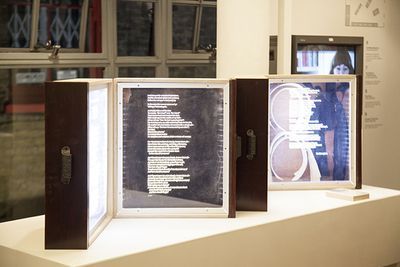Books unbound – and Prufrock in his cabinet
By MICHAEL CAINES
Whitechapel art gallery hosted the London Art Book Fair for the sixth year running last weekend, and a very fine affair it was too . . .
Whole tables of graphic novels from Canada stood next to delicate, bird-adorned matchboxes. Children’s books by Stefan Themerson, graced by Franciszka Themerson’s distinctive line drawings, lay next to the bright and bold London Jungle Book by Bhajju Shyam. The exhibitors, over two floors, included London galleries, art presses from across the Continent, academic presses (the MIT Press has done Marius Hentea’s TaTa Dada (about Tristan Tzara) and Branden Hookway’s Interface proud) and smaller-scale operations (I picked up a few issues of Mike Nicholson’s terrific seasonal “bio auto graphic”) – suggesting a thriving world of endless invention, diversity and abundance.
That’s books for you, art or no art, 560-odd years after Johannes Gutenberg printed his first poem.
In the light of this abundance of works in print, much of it but by no means all of it in familiar codex form, it was interesting to find, between floors, on the mezzanine level, a small exhibition courtesy of a publishing platform and a visual arts studio: Unbinding the Book. Its aim was to “push the boundaries of how books can be experienced, by evoking the storytelling properties of print and the way in which images evoke a narrative, whilst bringing to life the materiality, form and physicality that make books so alluring and different from their digital counterparts”.
This seems like a canny deployment of the word “alluring” to me. There were plenty of examples of the well-made book on traditional lines just downstairs, such as the new publication from Fitzcarraldo Editions, Memory Theatre by Simon Critchley, with its plain cover and typographical clarity. This kind of design does necessary work on behalf of a book’s author, making it easy to read and a pleasurable to carry around. The works on show in Unbinding the Book, meanwhile, illustrated how the fun of messing about with the physical format of books, crossing those apparent boundaries, can obscure or complicate the book’s conventional purpose as a vessel for the printed word.
There are, for example, words printed in Aymee Smith’s take on Craig Dworkin’s Reading the Illegible – a book about erasure and defacing the text – only they become increasingly illegible as you turn the pages as, via a process of copying onto acetate and cumulative scanned, the image of the first page merges with the next, and the next . . . and so on.
Or there’s the “book-radio” devised by Magz Hall, which looks like a hardback on life support – only the wires sticking out of it connect with a junkshop array of radios, out of which spout the words of Archbishop Frederick Du Vernet, the author of Spiritual Radio (published posthumously in 1925), who believed that radio waves could be the means of uniting his extensively scattered British Columbian flock in prayer. I wandered past it a couple of times, tuning in and out as the book read itself out.
Or there’s a third piece – in some ways the one that intrigued me most of all – Vince Koloski’s response to T. S. Eliot, “The Cabinet of J. Alfred Prufrock”:
Apart from anything else, I was intrigued because I couldn’t see any indication that Faber and the Eliot estate had granted permission for Koloski to reproduce the entire text of Eliot’s poem, as he had done here. In fact, Koloski publicly noted instead that permission wasn’t confirmed even as the work went on show; and the exhibition is meant to be going on to New York some time, so it's not an entirely academic matter. It would be a shame, I thought, if nobody else got to see the “Cabinet” as part of this exhibition – or maybe even in the context of some authorised celebration for “Prufrock” as it nears the centenary of its first publication in Poetry (Chicago), in June 1915. Fortunately for Koloski, the estate has now approved his work.
As part of Unbinding the Book at least, it offers the probably all too conventional pleasure of simply reading the poem in “unbound” form, from start to finish, but illuminated by hidden lights, with Prufrock-like accoutrements stowed behind the glass on which the text itself appears. Here's a neatly folded shirt fit for the "formulated" narrator, "pinned and wiggling on the wall", an array of stiff collars ("mounting firmly to my chin"), black braces that for some reason put me in mind of that the damned snickering Footman. . . .
In short: I don’t think a Blaise Cendrars aficionado, say, familiar with the “giant film strip” of La Prose du transssibérien et de la Petite Jehanne de France, or anyone familiar with a copy of The Unfortunates by B. S. Johnson or the alluring experiments of other artists would keel over in shock at anything on display during the Art Book Fair. But there was plenty of memorable, striking work on display. Not least in that Cabinet of Eliotic curiosities.
Roll on the Small Publishers Fair . . . .
Peter Stothard's Blog
- Peter Stothard's profile
- 30 followers





